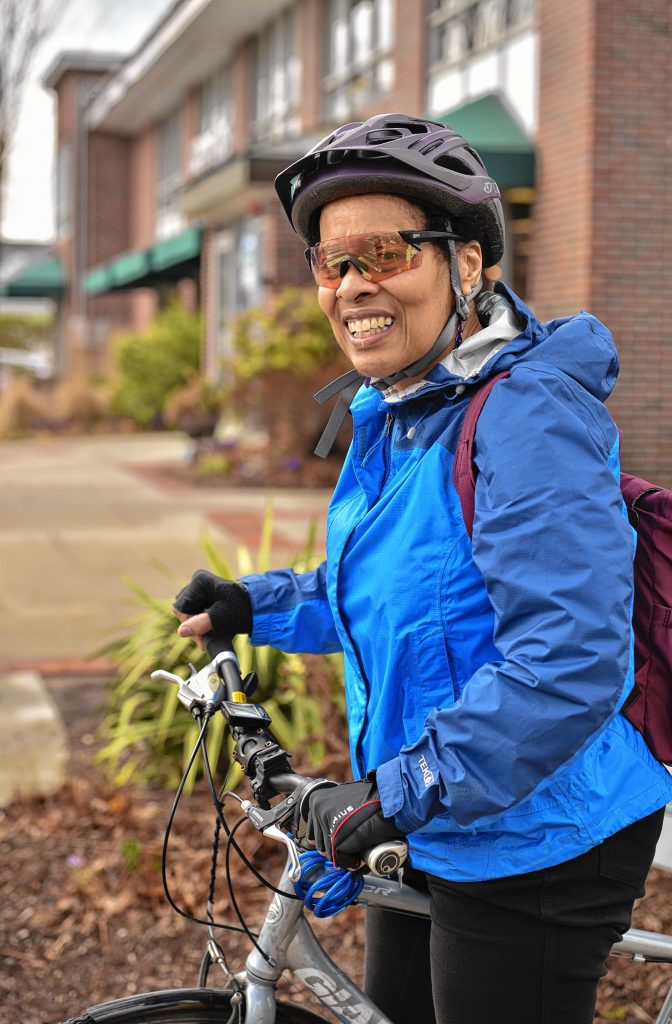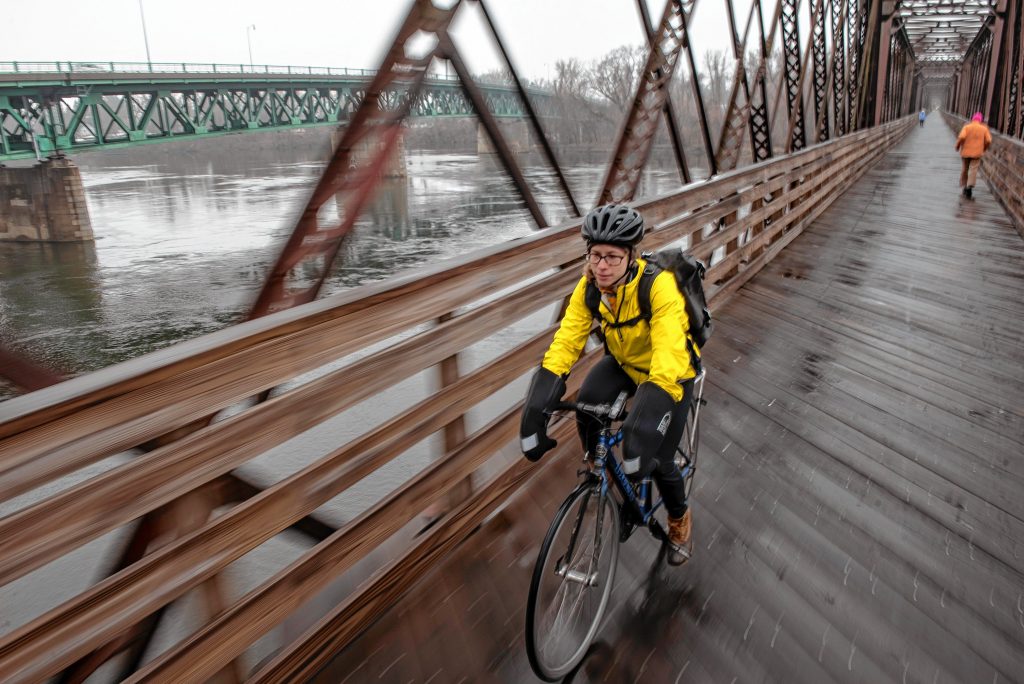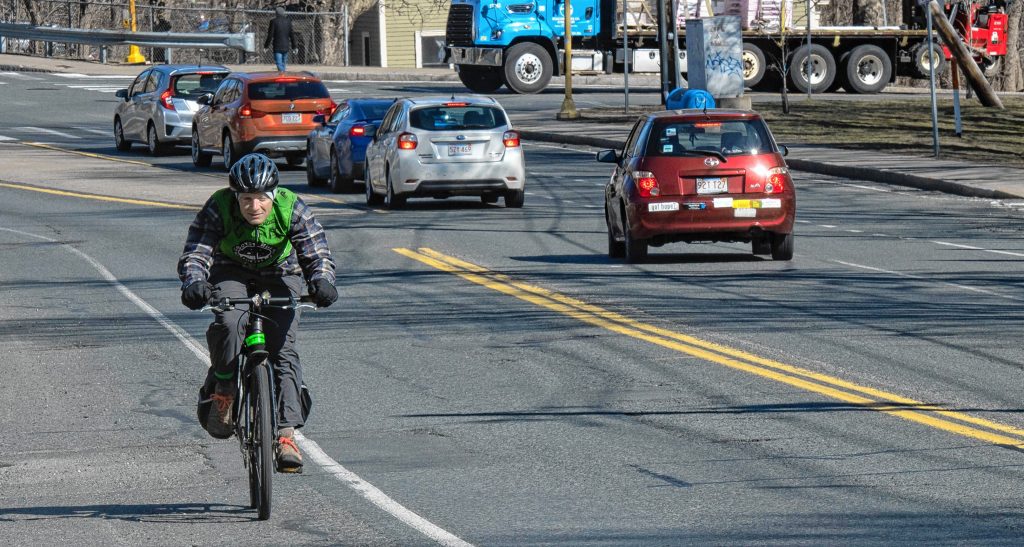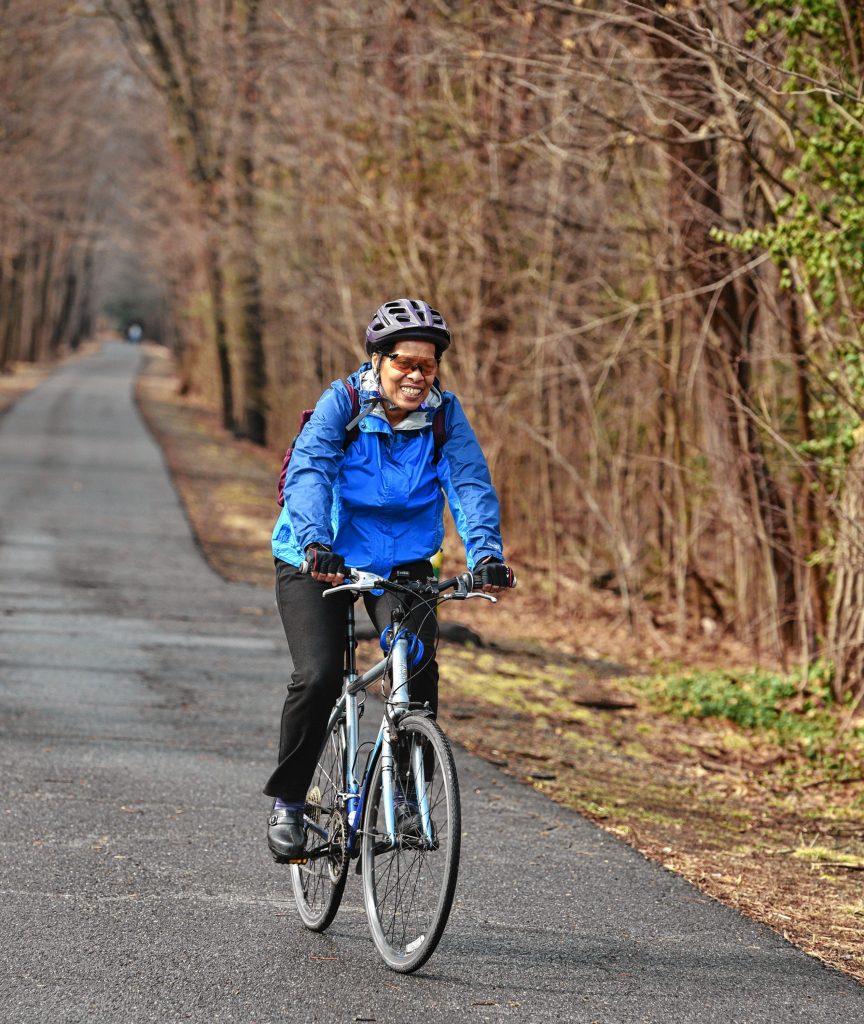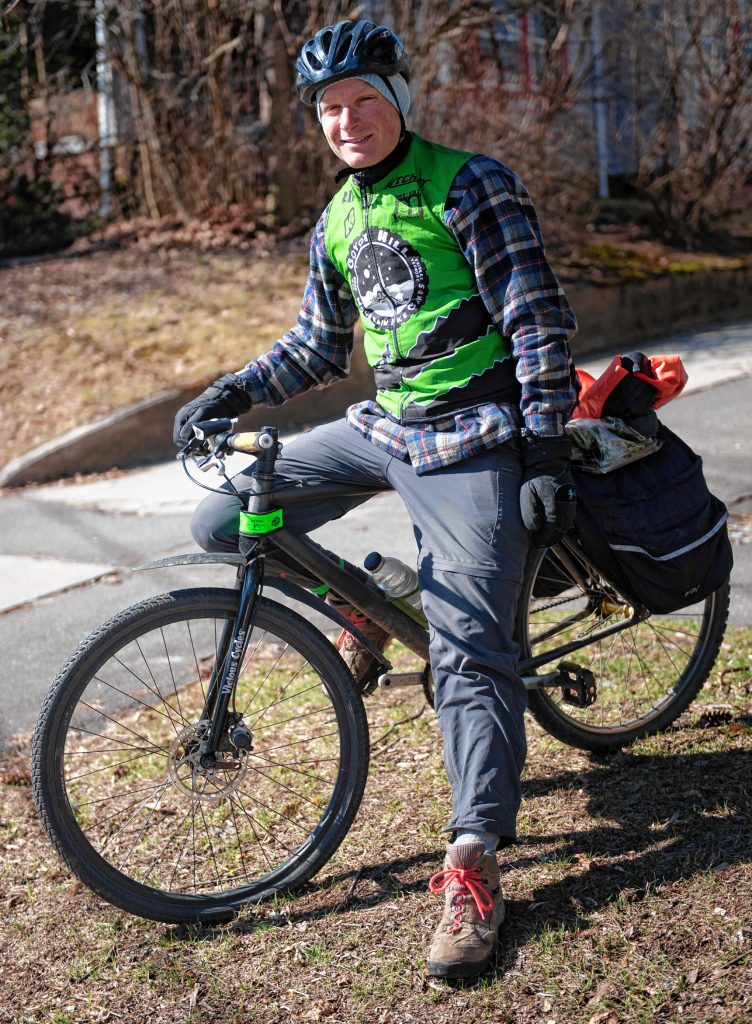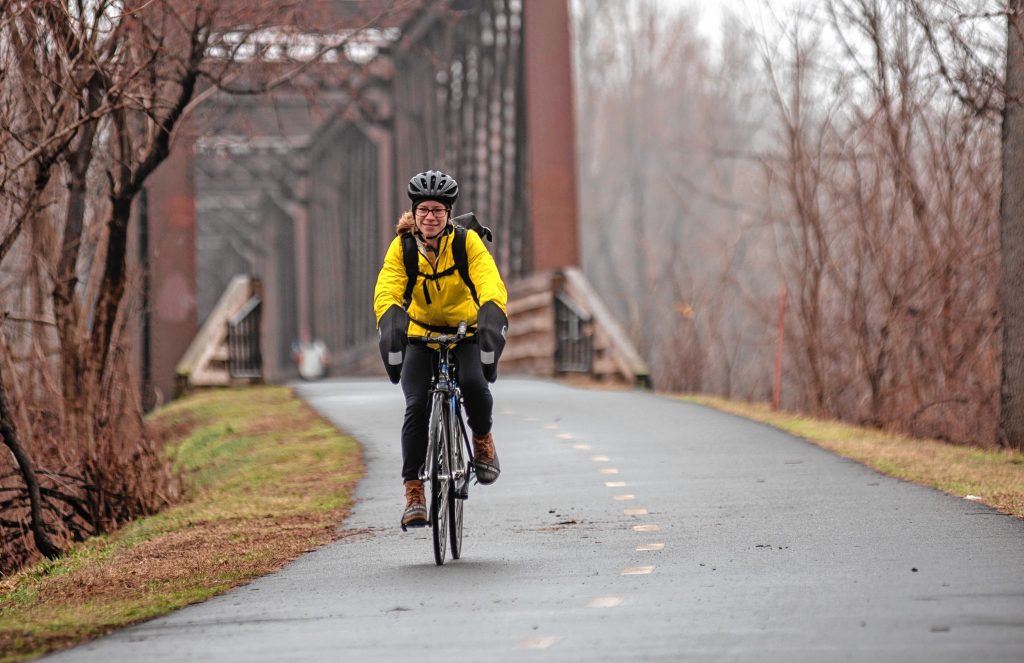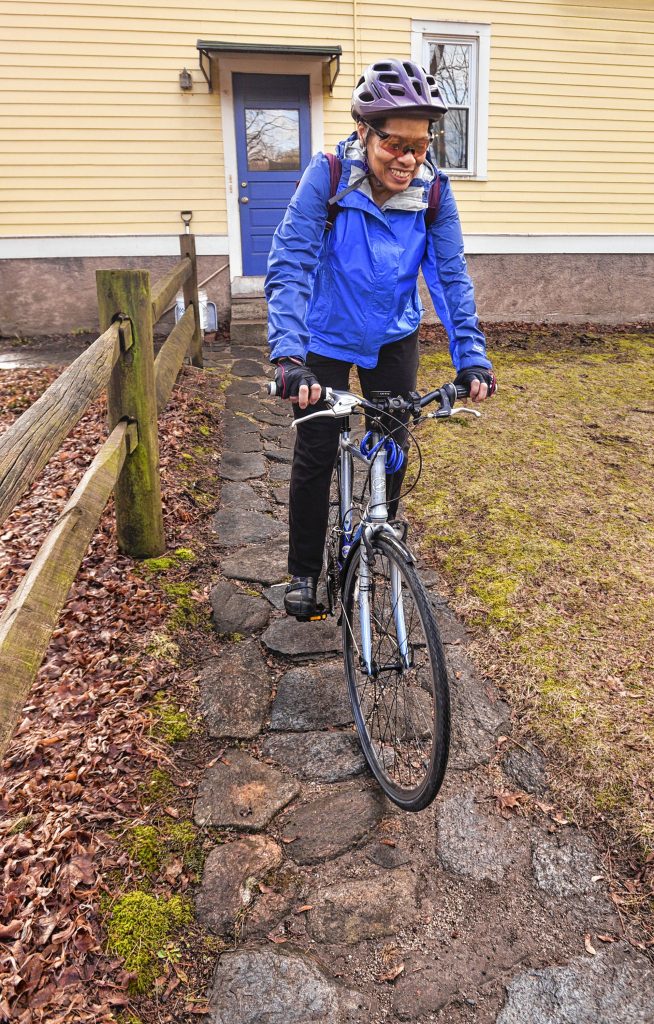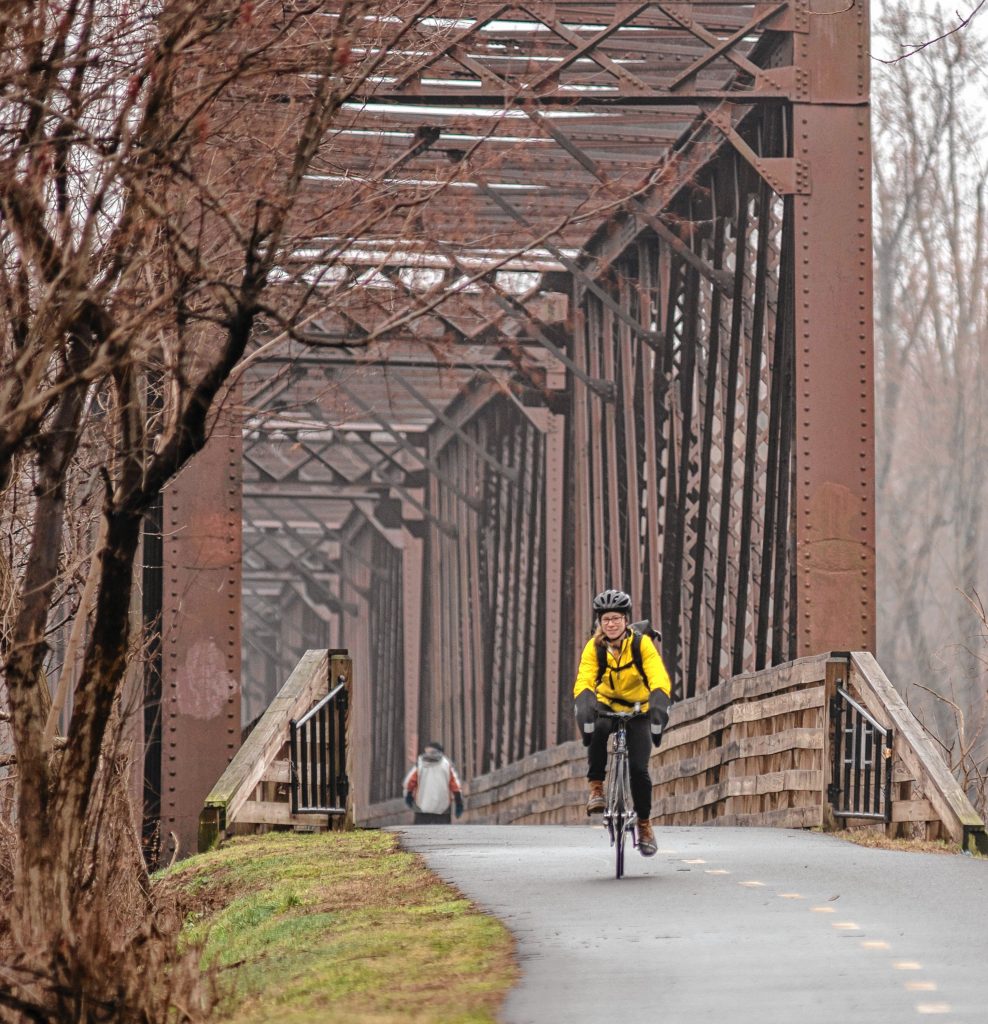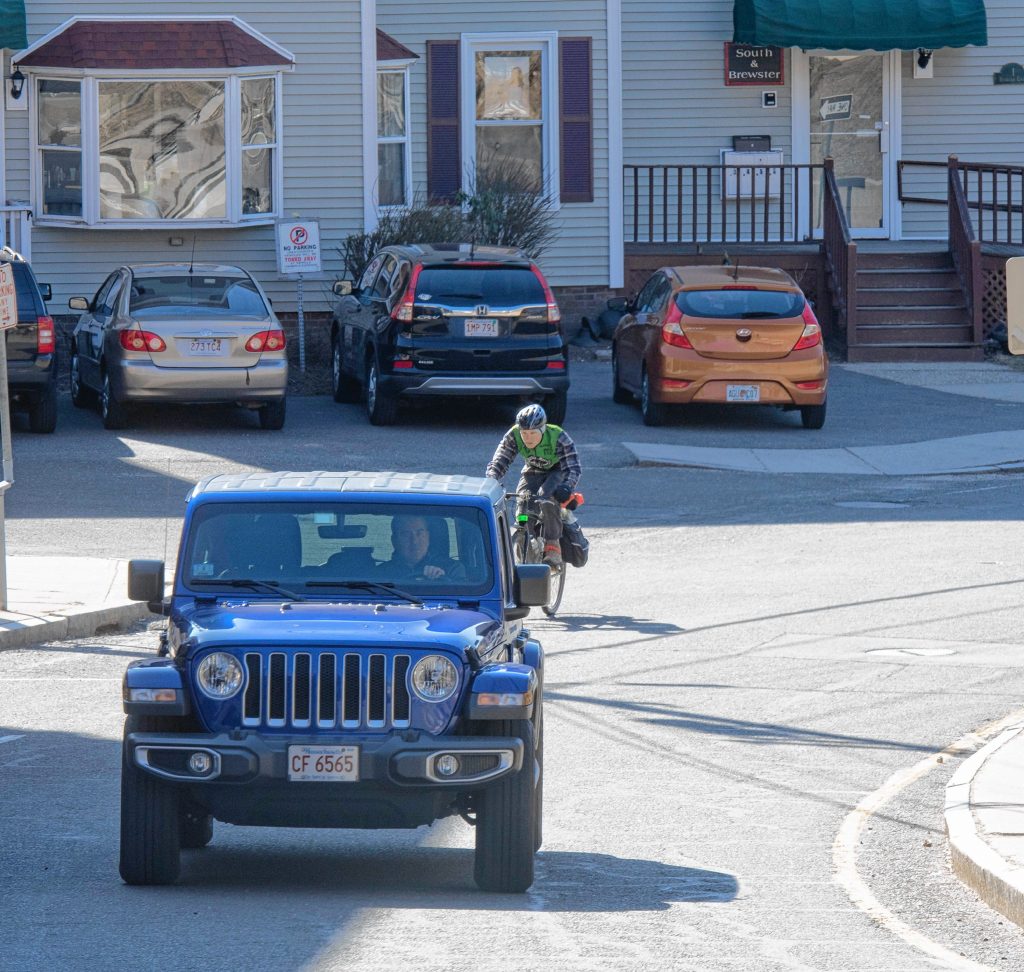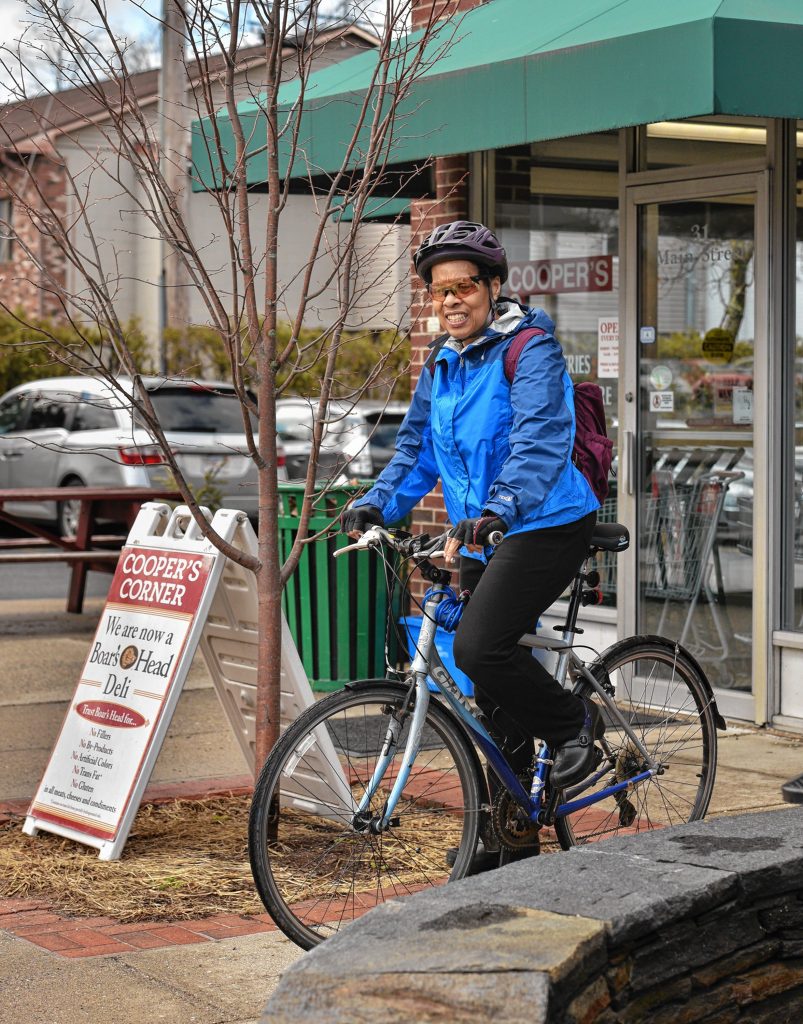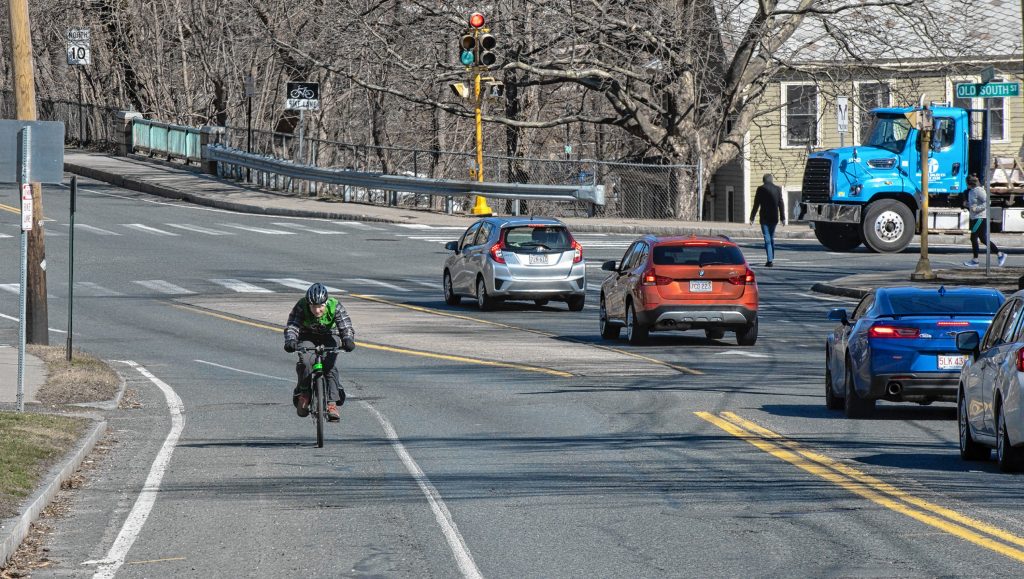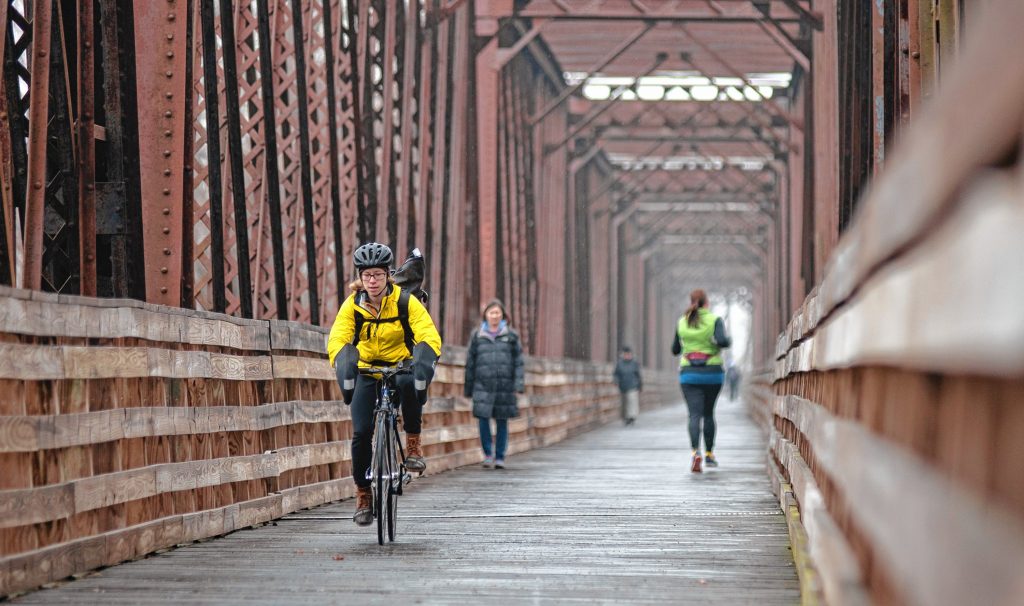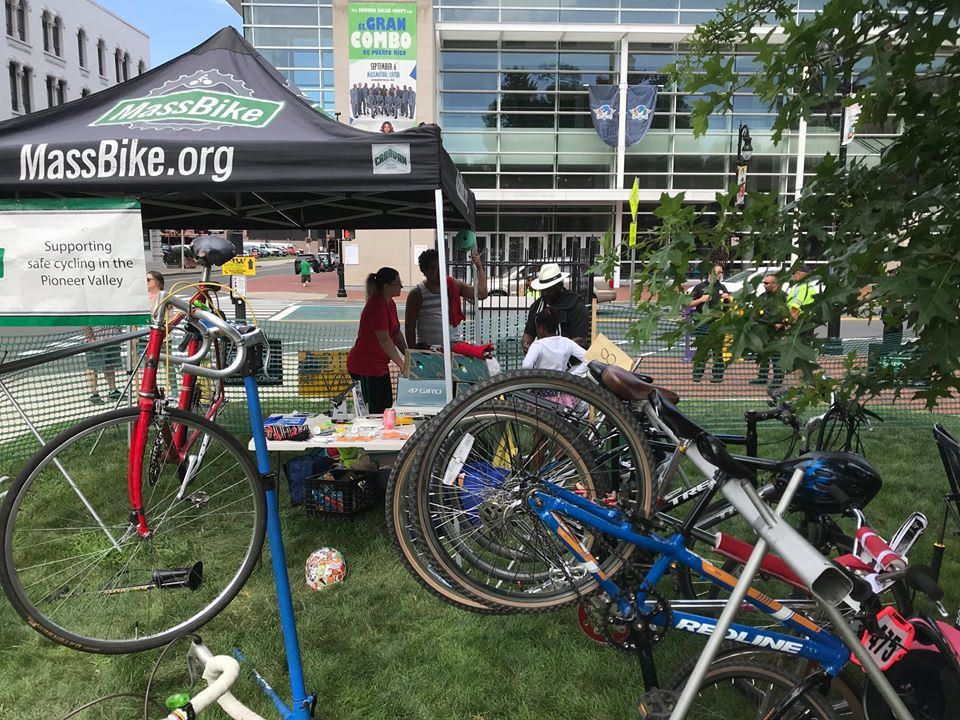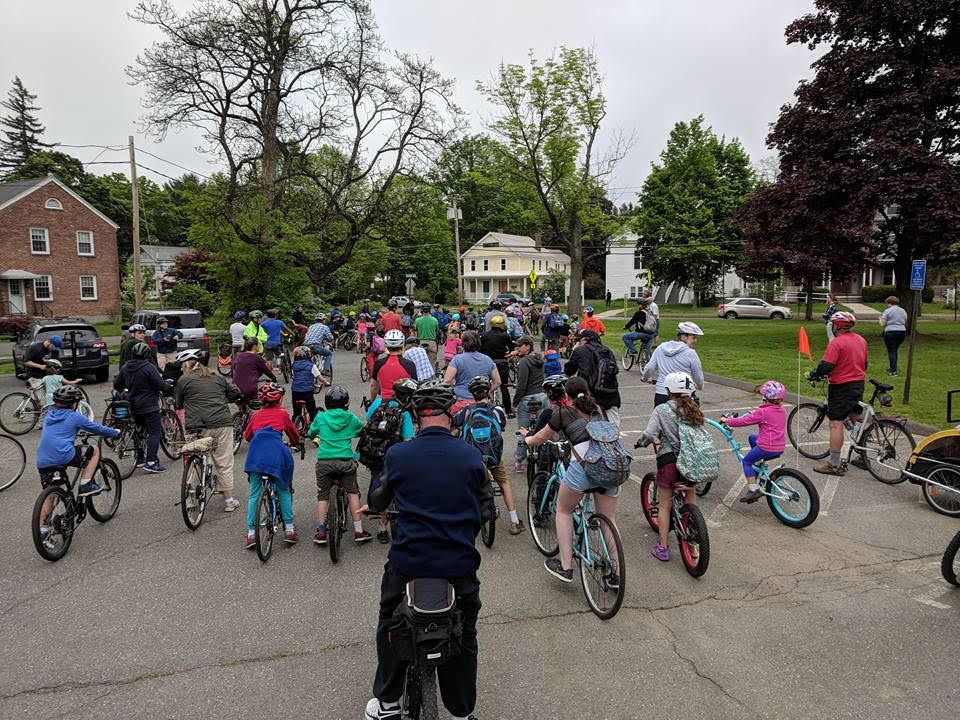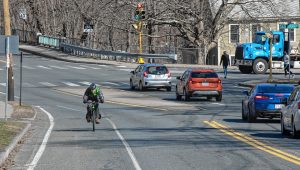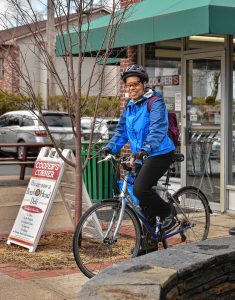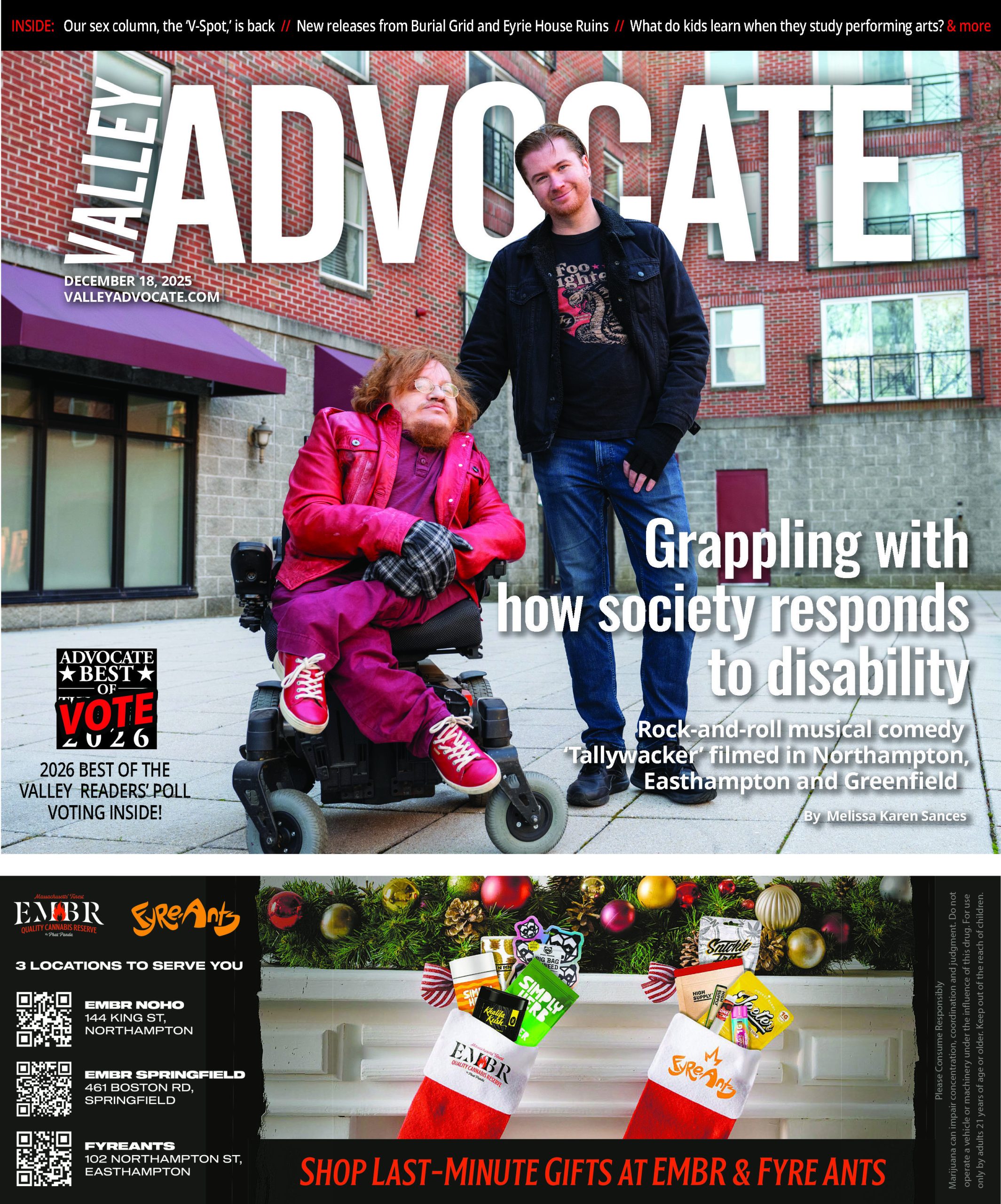Andrea Hairston was already a pretty serious bike commuter, riding through most kinds of weather to her teaching job at Smith College, when she had an encounter several years ago with the late Frances Crowe of Northampton. It was a cold winter day, with snow coming down, and Hairston was a passenger in a car that came abreast of the legendary social and political activist as she walked along Elm Street, pushing a small handcart.
Hairston, a science fiction and fantasy writer — she teaches creative writing at Smith — knew Crowe and stopped and asked her if she wanted a lift. “It was during the Iraq War, and she said ‘No — I don’t want to be contributing to this war for oil,’ ” Hairston recalls. “Francis must have been in her eighties then, and here she’s out walking in the snow. And I’m thinking, ‘Well, OK, if she can do that, maybe I should be riding my bike in winter, not just spring through fall.’”
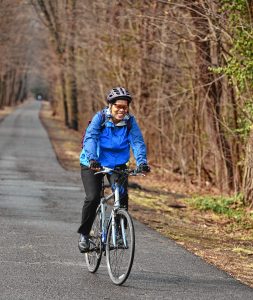
Andrea Hairston rides on the Northampton Rail Trail in Florence in mid March. She uses the path to commute to her job teaching writing at Smith College.
And so Hairston, who lives in Florence, got herself set up to do just that, investing in a special bike equipped for winter conditions, with studded tires, fenders and a rust-proof chain. Today she’s a year-round bicycle commuter, whether it’s going to work, the gym, running errands or just getting around for exercise. Rain is usually no impediment, either, she says. Her only concession, in the event of a torrential downpour, is to walk to work instead of cycling (she lives in a house with her wife and a friend, both of whom have cars).
“I love it,” says Hairston, who has been on sabbatical from Smith this semester. “I love the independence I have on a bicycle.”
For Hairston and other people in the Valley whose bicycles are their primary — or only — means of transportation, getting around on two wheels is not a hardship or sacrifice. It’s a conscious decision that can be based on any number of factors: a desire to limit one’s contribution to climate change; a way to relax and decompress after a day of work by cycling home rather than fighting traffic; a way to save money; or just having an aversion to cars.
Salem Mazzawy of Granby has owned cars in the past but doesn’t any longer. Though he doesn’t ride every day, Mazzawy, a former cross-country (XC) mountain bike racer, uses his bike for everything he does, whether a run to the grocery store in Hadley, a visit to a friend in Northampton or, in past years, for a trip to a place to cross-country ski (he would strap his skis along the length of his bike).
“I’m just far more comfortable on a bike,” he says during a phone interview. “It just doesn’t make a lot of sense for me to have a car right now.” He’s done different kinds of jobs in the past, including building his own house, and says he’s “been very fortunate” to have worked things out in his life such that “I don’t need to work right now.”
Like Hairston, he’s not put off by cycling in bad weather; proper clothing, headlights and reflectors, fenders and careful riding can all minimize the impact of wet or cold conditions, he says, even if that means he needs to do more maintenance to keep his drivetrain, brakes and gears clear of road grit.
“In my experience,” he wrote in a follow-up email, “as I used a bike more and more for functional transportation, I hit a tipping point where it was far more unpleasant to use my car than to hop on a bike. Once I made it to that mentally … it was just a matter of figuring out ways to accomplish what I needed without getting into the box on wheels. These days, I do what I can to avoid even being a passenger.”
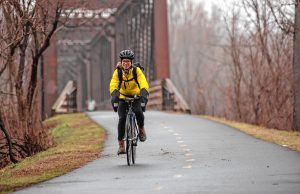
Physical therapist Jess Goldberg of Florence has regularly commuted by bicycle to her job in Hadley. Here she’s seen on the Norwottuck Rail Trail on her way to Tran’s World Food Market in Hadley.
With spring having arrived, bicyclists are again hitting the road in increasing numbers, even as the COVID-19 outbreak has thrown new wrinkles into the situation. Some bike commuters, like physical therapist Jessica Goldberg of Florence, are not going to work as frequently or at all. The virus has also led to cancellations of public biking events, like the annual “Bike to Work” week in May hosted by the Massachusetts Bicycling Coalition (MassBike). That event, which was slated to be expanded to a month this year, has now been rescheduled for September.
In addition, ValleyBike Share has not opened in early April as it did last year. The program is looking instead at an early May opening — roughly timed to coincide with the state’s proposed date to reopen schools — if health conditions permit it. Project Manager Wayne Feiden, Northampton’s director of planning and sustainability, says safety concerns both for riders and ValleyBike maintenance staff dictated the delay for the electric-assist bike share program, which has multiple stations in half a dozen Valley communities.
“There’s a real concern about the ability to clean the bikes properly right now,” says Feiden, who notes that some data from bike share programs in other parts of the country showed ridership dropping sharply in late March as the coronavirus outbreak gained steam.
But Kristen Sykes, the new president of the Pioneer Valley chapter of MassBike, says COVID-19 may be opening the door to increased cycling in other ways. Many people who are largely stuck at home are desperate to get out and get some fresh air, she says, and cycling is as good a means as any, with people more easily able to maintain social distancing on a bike. Other people will want to save money by making their bicycles their main source of transportation, she says.
“One of our longtime goals is to get more people out on group rides, all over the Valley — in Springfield, in Holyoke, not just in Hampshire County,” Sykes said in an interview in March at the Valley Advocate, before the COVID-19 outbreak had led health officials to stress social distancing for all activities. “It’s about raising awareness that you have plenty of people who do biking in cities — cyclists are out, you’re visible, and [drivers] think about it.” Drivers not used to seeing bicyclists “often don’t know how to deal with them, how to pass them safely,” she added.
MassBike and other cycling advocates say that, even given COVID-19, there’s reason to be optimistic about bicycling’s future in Massachusetts. In the past two decades, the state and an increasing number of towns have come a long way, advocates say, in recognizing that bicycles have a legitimate place on the road as a means of transport, not just recreation. The steady growth of bike lanes, rail trails, “traffic calming” means such as speed bumps, and the installation of bike racks on sidewalks have made more places bike-friendly.
Bike proponents also had a hand in crafting the state’s new “hands-free” driving law that ideally will keep drivers distracted by their cell phones from plowing into cyclists. Other protections for bicyclists, such as a law mandating that motorists keep a minimum distance of three feet from people on bikes (and other “vulnerable road users” such as first responders and pedestrians), are part of a bill that has passed the state Senate and is now in the House.
As well, communities such as Northampton are investigating the state’s “Complete Streets” program, which provides funding and technical assistance for cities and towns that want to redesign their downtown areas and main streets to make them safer and more accessible to pedestrians and bicyclists. Some possible redesigns for Main Street in Northampton can be seen as part of an online survey at surveymonkey.com/r/NorthamptonMainStreet.
“Things are moving in a really positive way,” said Sykes. “The state is really putting a lot of support into rail trails and other things.”
For example, she points to the collaboration between three state agencies — MassDOT, the Department of Conservation and Recreation, and the Executive Office of Energy and Environmental Affairs — on what’s known as the MassTrails program, which aims to connect different networks of off-road, shared-use pathways and recreational trails for multiple users. The program offers matching grants, technical assistance and others resources to people, towns and groups looking to improve these byways or build news ones, such as rail trails.
In addition, Northampton city officials, responding to Gov. Baker’s order in late March that all “non-essential” businesses in the state close due to COVID-19, passed a resolution stating bikes shops in town needed to remain open. “[R]esidents and businesses of Northampton use bicycles extensively as a primary means of transportation, and the ability to acquire and repair bicycles is essential for the transportation of members of the Northampton community,” the resolution said in part.
As Sykes sees it, that resolution likely reflects the thinking of, among others, three newer City Council members — Karen Foster, Alex Jarrett, and Rachel Maiore — who are all bicycling advocates. Jarrett, for instance, is a co-founder of Pedal People, the bike-based trash hauling service in Northampton, and he does not own a car.
“We’re looking forward to good things as we work with the City Council and all these new folks who are really excited about cycling,” said Sykes.
Minimizing risks
That said, cycling amidst cars, trucks and buses is not without risk. A report last year by MassDOT on bicycle transportation said an average of nine people die annually in the state in bicycling accidents, and that the number of non-fatal bike crashes increased 7% between 2010 and 2015, from 969 to 1,038.
 Bicyclists are particularly vulnerable in collisions with trucks, according to the report. Last July, cyclist Em Samolewicz, a graduate of Northampton High School and of a Smith College masters program in education, was killed in Brooklyn, N.Y. when she was hit by a tractor-trailer.
Bicyclists are particularly vulnerable in collisions with trucks, according to the report. Last July, cyclist Em Samolewicz, a graduate of Northampton High School and of a Smith College masters program in education, was killed in Brooklyn, N.Y. when she was hit by a tractor-trailer.
Part of the proposed state legislation to protect bicyclists includes a provision that would require trucks to install side guards between their front and rear wheel wells, so as to prevent cyclists and others from being swept underneath the vehicles in the event of a collision.
But Jessica Goldberg, the Florence physical therapist who has been commuting to her job in Hadley, says there are risks to everything — and she finds that the benefits she gets from riding to work, and getting around on her bike for fun and for many errands, far outweigh potential problems.
“I’ve always chosen mobility over being sedentary when it comes to transportation,” she said during a recent phone interview. In particular, she considers coming home from her job on two wheels “just a great way to unwind. It’s a period of time for mindfulness — it just makes me a better person.” She previously lived and cycled to work in Philadelphia, and her route was actually pretty safe, she notes, as much of it was along a bikeway. But commuting to work in the Valley has been even easier, as she can do almost all of it along the Northampton and Norwottuck rails trails: “It’s pretty and it’s protected.”
Bonus: She has access to a shower at work when she rides in on hot days.
Mazzawy, the Granby cyclist, says he’s long practiced “defensive cycling,” especially at night, by simply being cautious when he’s approaching a driver or cycling through a potentially problematic place like a rotary. But, he notes, drivers around here “by and large are fantastic — most are really good about passing you safely and recognizing your right to be on the road. It makes you really notice the bad ones so you can be on your guard.”
Sykes, the director of Southern New England Conservation Projects and Partnerships for the Appalachian Mountain Club, also commutes year-round by bike to her office in downtown Northampton from her home in Florence (heavy downpours excepted). She notes she only has to go a couple of miles, a trip that seems unnecessary by car.
In fact, the MassDOT bicycling report notes that “52% of all trips in the state are three miles or fewer — a typical biking distance for many people (about 16 minutes) — and yet 80% of those trips are currently made in vehicles.”
Part of the issue is that barriers remain, especially in cities, even to some short bike trips. Alex Weck, development coordinator for MassBike, has been part of an effort to create a bike park in Springfield, in part to alleviate clashes that have occurred between motorists and younger bikers, some of whom like to pop wheelies and do other stunts while riding. Last year, Mayor Dominic Sarno referred to cyclists as “miscreants” who flout traffic laws; some saw the comments as unfairly broad brush as well as racially charged, as many of the younger riders are Latino and African American.
Weck, who organizes regular bike events in the city that are aimed at young riders — it’s called RADSpringfield — says bicycling advocates have now been cleared to apply for grant funding for a bike and skate park in Springfield, with the money to be allocated through the city’s Community Preservation Fund. But the more long-term battle in making the city more accessible to cycling, he says, is overcoming decades of development that never factored bicycle travel into the mix.
“As a state, we’re way ahead of many others when it comes to improving access and safety for bicycling,” he said. “But it’s certainly not true everywhere.” In Springfield, he notes, bike lanes were put in place on some roads where people had previously parked, but without any public education campaign to alert the public to the change, “people kept parking in the same places.”
Weck also wonders whether race has been a factor in a lack of development of additional bikeways and amenities in the city. With the exception of Springfield’s 3.7-mile Connecticut River Walk and Bikeway, he noted, “You have all these bikeways in Hampshire County, but they just come to an end when you come down here.”
Sykes says she’d also like to see improved access for cyclists in places like Springfield and Holyoke. Part of MassBike’s efforts along those lines is making cyclists more proactive and confident by, as one example, holding educational events such as bike repair workshops and updates on the “rules of the road”: what cyclists are allowed to do (such as riding two abreast as long as you’re not impeding faster traffic) and obligated to do (stop at red lights likes drivers do). Sykes says MassBike has also forged connections with groups like Venture Out, a national program designed to get members of the LGBTQ community outdoors.
Pioneer Valley MassBike has had to cancel a number of those events this spring because of COVID-19 but hopes to reschedule them when conditions improve. The long-term goal remains the same, says Sykes: get more people on bikes. She’s spent time in countries like Denmark, Germany and the Netherlands, where a much higher percentage of people than in the U.S. use bicycles for getting around, since cities and towns have specifically factored cyclists into their planning, both for transportation and general livability.
“If we have infrastructure in Massachusetts and in western Mass that makes people feel more comfortable cycling, than more people will do it,” she said. “People want to do it — they’re thinking of climate change, it’s good for your health, you can save money. There are so many good reasons. Let’s make it more accessible.”
Steve Pfarrer can be reached at spfarrer@valleyadvocate.com.

